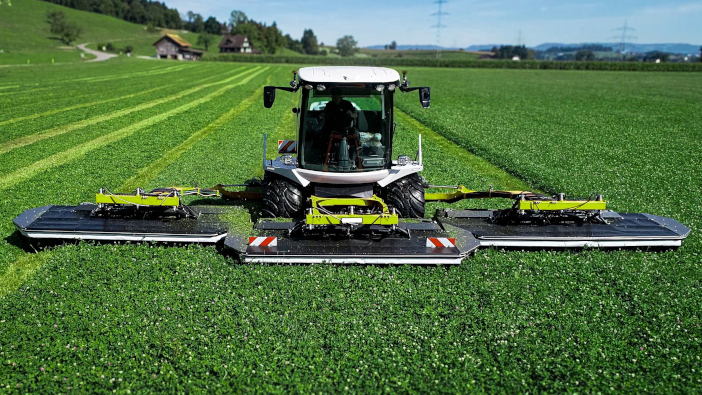The biggest news on the Fliegl stand will be the Cutaro self-propelled mower, acquired from Kirchdorf, and undergoing further development. Details are light on the ground at the moment, but the machine is currently undergoing testing and refining, with a pilot series set to be delivered to select customers throughout 2026 ahead of a full launch in 2027.
Staying with the company’s grassland portfolio, a new pickup and chopping rotor are also being launched for Cargos loader wagon range. The PickUp Pro 2.35 offers a 2.35m working width, with a small 320mm diameter rotor to work in even the wettest silage, according to the company.
Five rows of tines are fitted to the rotor, and the unit is driven from both sides to limit wear. It is pendulum-mounted, providing vertical movement of up to 20cm to accurately follow ground contours, with the option of hydraulic pickup relief.
The CargoCut 24 chopping rotor features 63 double-sided knives, arranged in a helical pattern around an 860mm diameter rotor. It’s designed for short chop silage, offering a theoretical chop length of just 24mm.
Thanks to the company’s Mix & Match system, the new pickup and chopping rotor have a modular design, enabling them to be fitted to any Cargos machine. According to the company, this will allow users to design their own wagon based on their individual needs.
Automatic axle control and attachment recognition
Moving on to Fliegl’s transport and spreading technology, the company will introduce the HydroLift axle. It uses an integrated load sensor within the hydropneumatic drawbar suspension, which responds to the actual load of the towing vehicle, rather than the axle load distribution.
If an overload is detected, the front axle of the following trailer is automatically lowered to improve stability and protect the towing vehicle. This means the system can also react to changing loads, such as with muckspreaders. By linking to the drawbar system, it also prevents the axle from being raised when the load decreases due to unloading or when operating on slopes.
This is thanks to a time-delayed pressure measurement, which stops incorrect responses due to momentary peaks in the load. If there is a failure within the system, the axle will automatically lower to maintain safe operation.
When the axle is raised, tyre wear and fuel consumption are reduced, minimising operational costs.
Finally, the ASW push-off trailer range has been updated with an automatic attachment recognition system – working through Isobus and reducing the hydraulic requirement to just three hoses.
When the attachment is recognised, the Isobus universal terminal automatically changes, showing functions relevant to that attachment. According to the company, this will significantly reduce the time required to swap over rear attachments when changing over from muckspreading to silage hauling, for example.


